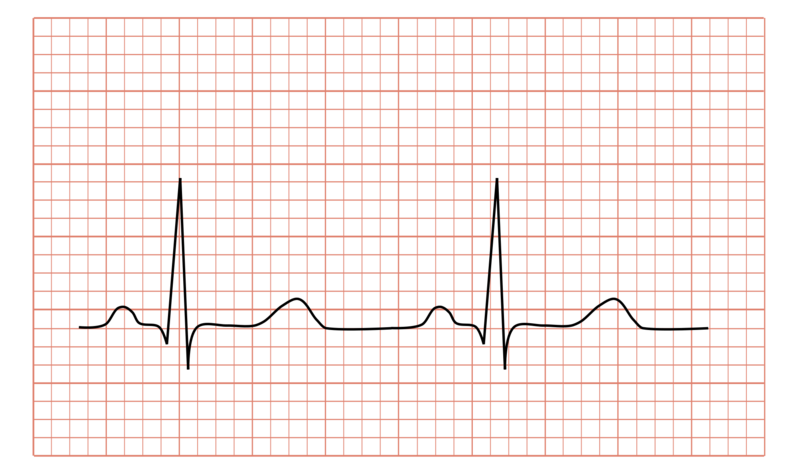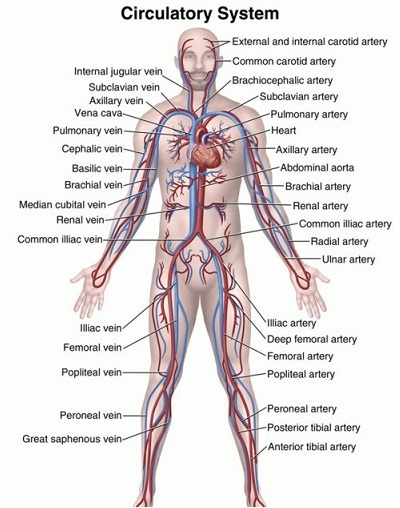12th Grade > Biology
BODY FLUIDS AND CIRCULATION MCQs
Total Questions : 59
| Page 3 of 6 pages
Answer: Option C. -> Increase in number
:
C
The main function of RBCs is to carry and deliver oxygen to body tissues which is essential for cellular respiration.The oxygen saturation is very low in high altitudes. To maintain a constant supply of oxygen to body tissues to function normally, RBCs will increase in number.
:
C
The main function of RBCs is to carry and deliver oxygen to body tissues which is essential for cellular respiration.The oxygen saturation is very low in high altitudes. To maintain a constant supply of oxygen to body tissues to function normally, RBCs will increase in number.
Question 22. The (i)___, controls both the heart rate and the stroke volume. There are two separate nerves from the cardiovascular centre to the sinoatrial node: the (ii)___, to speed up the heart rate and the (iii)___, to slow it down. (i) receives information from special cells called (iv)___, present in the aortic arch and in the carotid sinus.
Answer: Option B. -> (i) Cardiac centre, (ii) Sympathetic system, (iii) Parasympathetic system, (iv) Baroreceptors
:
B
There are two very important cardiac centres in the medulla called the vasomotor centre and the cardiovagalcentre. The vasomotor centre sends signals through the sympathetic nervous system which, in turn, controls the heart and vessels through the secretion of norepinephrine or noradrenaline. The cardiovagal centre, as the name suggests, sends signals through the parasympathetic pathway, specifically the vagal nerve. This centre is responsible mainly for decreasing the heart rate.The cardiac centres receive information from special cells called baroreceptors present in the aortic arch and in the carotid sinus.
:
B
There are two very important cardiac centres in the medulla called the vasomotor centre and the cardiovagalcentre. The vasomotor centre sends signals through the sympathetic nervous system which, in turn, controls the heart and vessels through the secretion of norepinephrine or noradrenaline. The cardiovagal centre, as the name suggests, sends signals through the parasympathetic pathway, specifically the vagal nerve. This centre is responsible mainly for decreasing the heart rate.The cardiac centres receive information from special cells called baroreceptors present in the aortic arch and in the carotid sinus.
Answer: Option A. -> (i) diastole phase, (ii) relax, (iii) systole phase, (iv) contract
:
A
The cardiac cycle is the sequence of events that occurs when the heart beats. In the diastole phase, the heart ventricles relax and helpfill the heart with blood. In the systole, the ventricles contract and pump the blood to the body through the arteries. The ventricular systole and diastole, are considered to be the systole and diastole of the heart beat.
:
A
The cardiac cycle is the sequence of events that occurs when the heart beats. In the diastole phase, the heart ventricles relax and helpfill the heart with blood. In the systole, the ventricles contract and pump the blood to the body through the arteries. The ventricular systole and diastole, are considered to be the systole and diastole of the heart beat.
Answer: Option B. -> Treating the mother with anti Rh antibodies
:
B
Erythroblastosis fetalis can be prevented by giving the mother anti Rh antibodies. These antibodies attach to the Rh antigens now circulating in the mother’s bloodstream and prevent her own immune cells from recognising the antigen. This in turn prevents the mother from forming her own antibodies against the Rh antigen, protecting the next child from Rh incompatibility related disease.
:
B
Erythroblastosis fetalis can be prevented by giving the mother anti Rh antibodies. These antibodies attach to the Rh antigens now circulating in the mother’s bloodstream and prevent her own immune cells from recognising the antigen. This in turn prevents the mother from forming her own antibodies against the Rh antigen, protecting the next child from Rh incompatibility related disease.
Answer: Option D. -> Bacterial infection
:
D
The neutrophils form 50-60% of the white blood cell composition. They are round cells with a multi-lobed nucleus. An inflammation or infection, elevates the production of neutrophils. Some neutrophils signal other neutrophils and they play an important role in thwarting a bacterial infection. So if the neutrophils content in blood increases, then the infection could be bacterial.
:
D
The neutrophils form 50-60% of the white blood cell composition. They are round cells with a multi-lobed nucleus. An inflammation or infection, elevates the production of neutrophils. Some neutrophils signal other neutrophils and they play an important role in thwarting a bacterial infection. So if the neutrophils content in blood increases, then the infection could be bacterial.
Answer: Option A. -> The electrical activity of the heart
:
A
ECG or an electrocardiogram is used to obtain a graphical record of the electrical current that is produced by the electrical activity and excitation of the heart. An ECG is obtained by leads or electrodes placed on the body that detect electrical impulses passing through the skin, but originate from the heart.

:
A
ECG or an electrocardiogram is used to obtain a graphical record of the electrical current that is produced by the electrical activity and excitation of the heart. An ECG is obtained by leads or electrodes placed on the body that detect electrical impulses passing through the skin, but originate from the heart.

Answer: Option B. -> To provide a medium for transportation, elimination of waste and maintain homeostasis.
:
B
The circulatory system is a vast network of organs and vessels that is responsible for the flow of blood, nutrients, hormones, oxygen and other gases to and from cells.The circulatory system is the body’s transit system -equivalent to roads, railways, waterways and airways that provide a medium for transportation.

:
B
The circulatory system is a vast network of organs and vessels that is responsible for the flow of blood, nutrients, hormones, oxygen and other gases to and from cells.The circulatory system is the body’s transit system -equivalent to roads, railways, waterways and airways that provide a medium for transportation.

Answer: Option A. -> Blood pressure, pulse, cardiac output.
:
A
The 3 variables which measure the efficiency of the cardiac cycle and the heart’s pumping activity are blood pressure, cardiac output, and pulse. The pulse tells us if the SA node is functioning efficiently, the blood pressure tells us if the heart is pumping at the right pressure, and the cardiac output which refers to the total output of the heart (for example, in liters per min.), tells us if theneeds of the body are being met by the heart.
:
A
The 3 variables which measure the efficiency of the cardiac cycle and the heart’s pumping activity are blood pressure, cardiac output, and pulse. The pulse tells us if the SA node is functioning efficiently, the blood pressure tells us if the heart is pumping at the right pressure, and the cardiac output which refers to the total output of the heart (for example, in liters per min.), tells us if theneeds of the body are being met by the heart.
Answer: Option C. -> Production and maturation of blood cells in bone marrow
:
C
Haematopoiesis is the process of blood cell production and maturation in the bone marrow.
:
C
Haematopoiesis is the process of blood cell production and maturation in the bone marrow.
Answer: Option C. -> Assertion [A] is True and Reason [R] is True and is a correct explanation to [A].
:
C
When the second (or third) helpings of those heavy-hitters go down, blood flows to the digestive system to ramp up its efforts. As a result, the rest of the body’s systems (including the brain) can start to feel a slowdown. Think of this as “rest and digest”— the opposite of the “fight or flight” response. We can also redistribute blood flow to areas that need it more through vasodilation, rerouting it from areas that need it less at that point through vasoconstriction. This is one of the reasons we feel tired after a huge meal. A huge amount of blood rushes to supply our gut during digestion.
:
C
When the second (or third) helpings of those heavy-hitters go down, blood flows to the digestive system to ramp up its efforts. As a result, the rest of the body’s systems (including the brain) can start to feel a slowdown. Think of this as “rest and digest”— the opposite of the “fight or flight” response. We can also redistribute blood flow to areas that need it more through vasodilation, rerouting it from areas that need it less at that point through vasoconstriction. This is one of the reasons we feel tired after a huge meal. A huge amount of blood rushes to supply our gut during digestion.
















